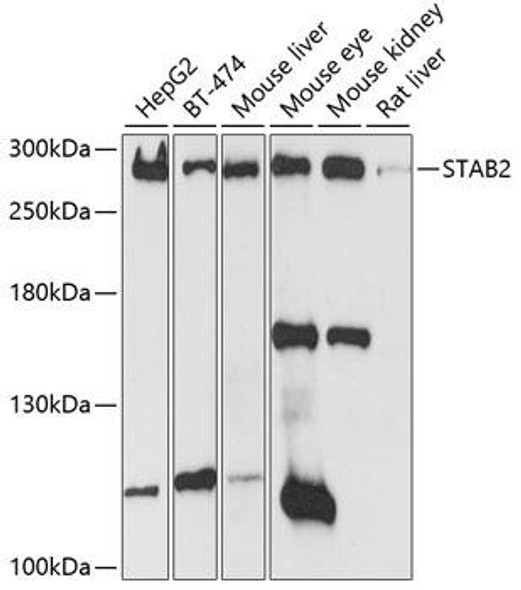Anti-CaMKII Antibody (CAB0198)
- SKU:
- CAB0198
- Product type:
- Antibody
- Antibody Type:
- Monoclonal Antibody
- Reactivity:
- Human
- Mouse
- Rat
- Host Species:
- Rabbit
- Isotype:
- IgG
- Synonyms:
- CAM2
- CAMK2
- CAMKB
Description
| Product Name: | CaMKII Rabbit mAb |
| Product Code: | CAB0198 |
| Size: | 20uL, 50uL, 100uL |
| Synonyms: | CAM2, CAMK2, CAMKB |
| Applications: | WB, IHC |
| Reactivity: | Human, Mouse, Rat |
| Host Species: | Rabbit |
| Immunogen: | A synthesized peptide derived from human CaMKII |
| Applications: | WB, IHC |
| Recommended Dilutions: | WB 1:500 - 1:2000 IHC 1:50 - 1:200 |
| Reactivity: | Human, Mouse, Rat |
| Positive Samples: | Mouse brain, Rat brain, C6, SH-SY5Y, U-251MG |
| Immunogen: | A synthesized peptide derived from human CaMKII |
| Purification Method: | Affinity purification |
| Storage: | Store at -20°C. Avoid freeze / thaw cycles. Buffer: PBS with 0.02% sodium azide, 0.05% BSA, 50% glycerol, pH7.3. |
| Isotype: | IgG |
| Sequence: | Email for sequence |
| Gene ID: | 816 |
| Uniprot: | Q13554 |
| Cellular Location: | Cytoplasm, Cytoplasmic side, Peripheral membrane protein, Sarcoplasmic reticulum membrane, centrosome, cytoskeleton, microtubule organizing center |
| Calculated MW: | 54kDa |
| Observed MW: | 50kDa/55kDa/60kDa |
| UniProt Protein Function: | CAMK2B: a widely expressed protein kinase of the calcium/calmodulin-dependent protein kinase (CAMK) group. Functions autonomously after Ca2+/calmodulin-binding and autophosphorylation. Involved in dendritic spine and synapse formation, neuronal plasticity and regulation of sarcoplasmic reticulum Ca2+ transport in skeletal muscle. In neurons, plays an essential structural role in the reorganization of the actin cytoskeleton during plasticity by binding and bundling actin filaments in a kinase-independent manner. This structural function is required for correct targeting of CaMK2A, which acts downstream of NMDAR to promote dendritic spine and synapse formation and maintain synaptic plasticity which enables long-term potentiation (LTP) and hippocampus-dependent learning. In developing hippocampal neurons, promotes arborization of the dendritic tree and in mature neurons, promotes dendritic remodeling. Participates in the modulation of skeletal muscle function in response to exercise. In slow-twitch muscles, is involved in regulation of sarcoplasmic reticulum (SR) Ca2+ transport and in fast-twitch muscle participates in the control of Ca2+ release from the SR through phosphorylation of triadin, a ryanodine receptor-coupling factor, and phospholamban, an endogenous inhibitor of SERCA2. The holoenzyme is composed of 4 different chains: alpha (CAMK2A), beta (CAMK2B), gamma (CAMK2G), and delta (CAMK2D). The different isoforms assemble into homo- or heteromultimeric holoenzymes composed of 12 subunits with two hexameric rings stacked one on top of the other. Interacts with SYNGAP1 and CAMK2N2. Interacts with MPDZ. Expressed in adult and fetal brain. Expression is slightly lower in fetal brain. Expressed in skeletal muscle and induced during exercise. Eight isoforms of the human protein are produced by alternative splicing |
| UniProt Protein Details: | Protein type:EC 2.7.11.17; Kinase, protein; Protein kinase, CAMK; Protein kinase, Ser/Thr (non-receptor); CAMK group; CAMK2 family Chromosomal Location of Human Ortholog: 7p14.3-p14.1 Cellular Component: nucleoplasm; sarcoplasmic reticulum membrane; plasma membrane; microtubule organizing center; spindle midzone; cytosol Molecular Function:calmodulin binding; protein homodimerization activity; calmodulin-dependent protein kinase activity; actin binding; ATP binding Biological Process: regulation of long-term neuronal synaptic plasticity; regulation of skeletal muscle adaptation; protein amino acid autophosphorylation; cytokine and chemokine mediated signaling pathway; regulation of calcium ion transport; signal transduction; protein amino acid phosphorylation; regulation of synaptic transmission, cholinergic; inhibitory G-protein coupled receptor phosphorylation; synaptic transmission; peptidyl-serine phosphorylation; response to cadmium ion; calcium ion transport; regulation of synapse structural plasticity; neuromuscular process controlling balance; G1/S transition of mitotic cell cycle |
| NCBI Summary: | The product of this gene belongs to the serine/threonine protein kinase family and to the Ca(2+)/calmodulin-dependent protein kinase subfamily. Calcium signaling is crucial for several aspects of plasticity at glutamatergic synapses. In mammalian cells, the enzyme is composed of four different chains: alpha, beta, gamma, and delta. The product of this gene is a beta chain. It is possible that distinct isoforms of this chain have different cellular localizations and interact differently with calmodulin. Alternative splicing results in multiple transcript variants. [provided by RefSeq, May 2014] |
| UniProt Code: | Q13554 |
| NCBI GenInfo Identifier: | 334302890 |
| NCBI Gene ID: | 816 |
| NCBI Accession: | Q13554.3 |
| UniProt Secondary Accession: | Q13554,O95437, O95438, O95599, Q9UGH7, A4D2K0, A4D2K1 A4D2K2, A4D2K3, A4D2K4, A4D2K5, A4D2K6, |
| UniProt Related Accession: | Q13554 |
| Molecular Weight: | 664 |
| NCBI Full Name: | Calcium/calmodulin-dependent protein kinase type II subunit beta |
| NCBI Synonym Full Names: | calcium/calmodulin-dependent protein kinase II beta |
| NCBI Official Symbol: | CAMK2B |
| NCBI Official Synonym Symbols: | CAM2; CAMK2; CAMKB |
| NCBI Protein Information: | calcium/calmodulin-dependent protein kinase type II subunit beta; caMK-II subunit beta; CaM-kinase II beta chain; CaM kinase II beta subunit; proline rich calmodulin-dependent protein kinase |
| UniProt Protein Name: | Calcium/calmodulin-dependent protein kinase type II subunit beta |
| Protein Family: | 6-oxocamphor hydrolase |
| UniProt Gene Name: | CAMK2B |
| UniProt Entry Name: | KCC2B_HUMAN |










